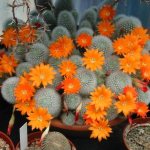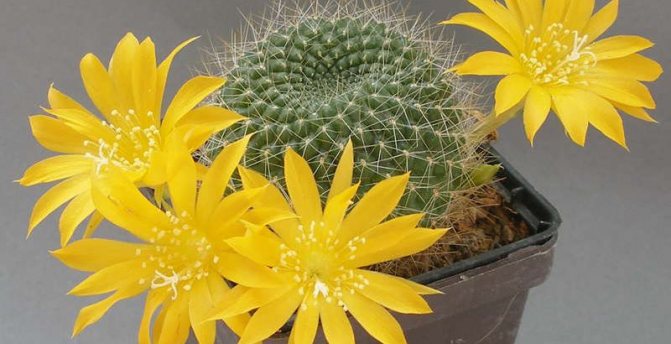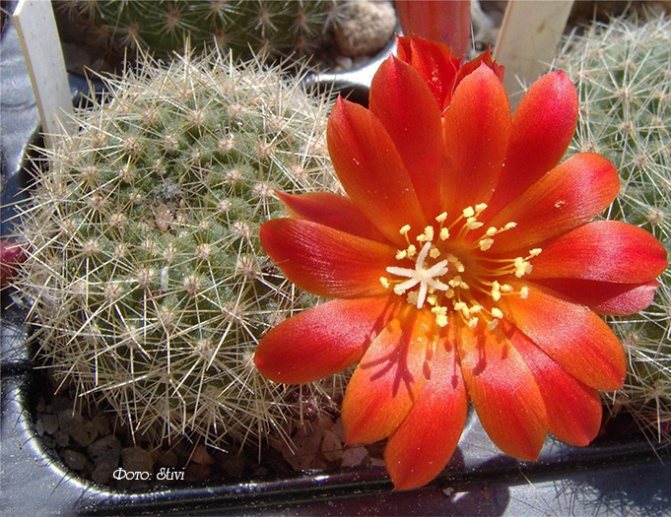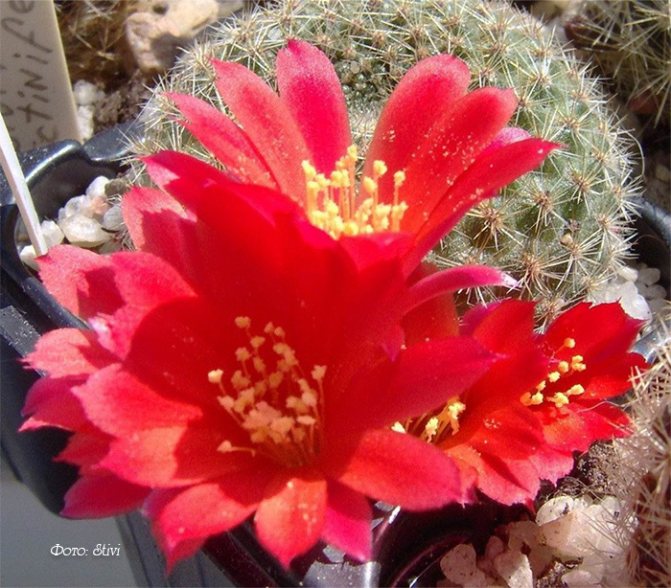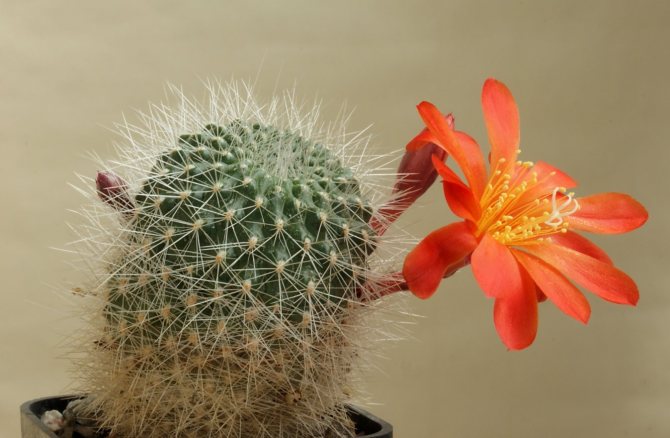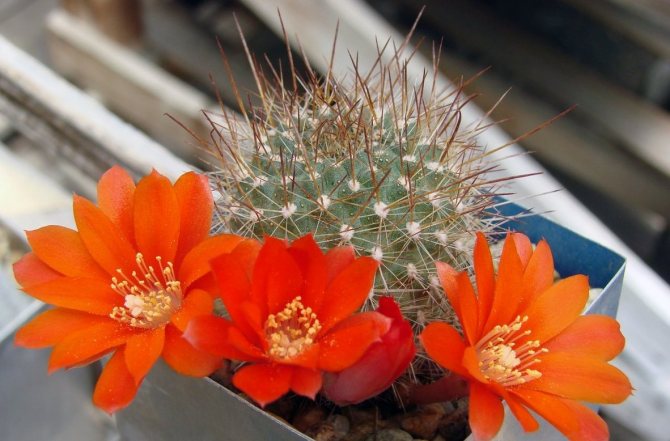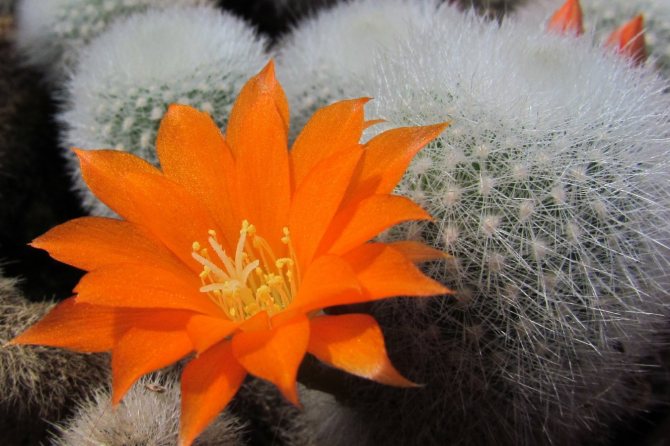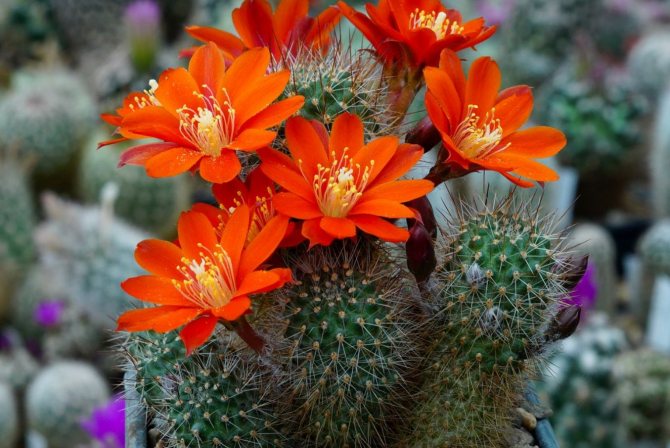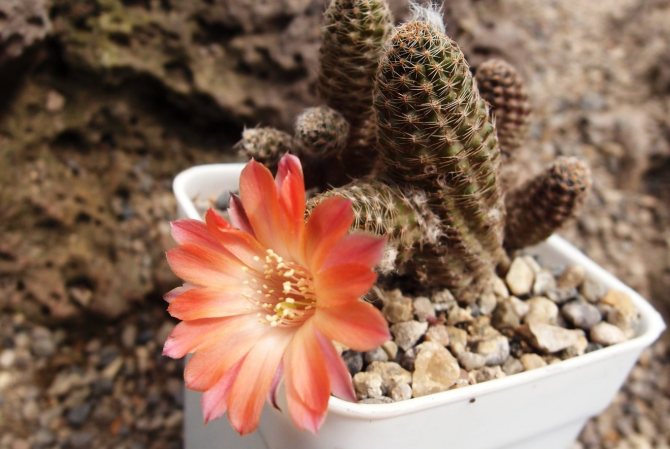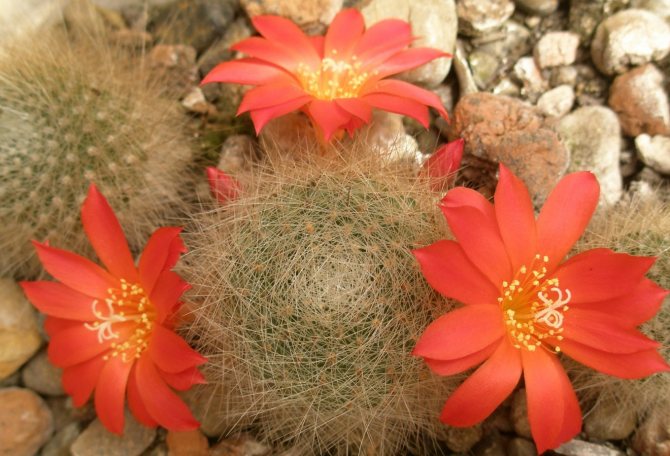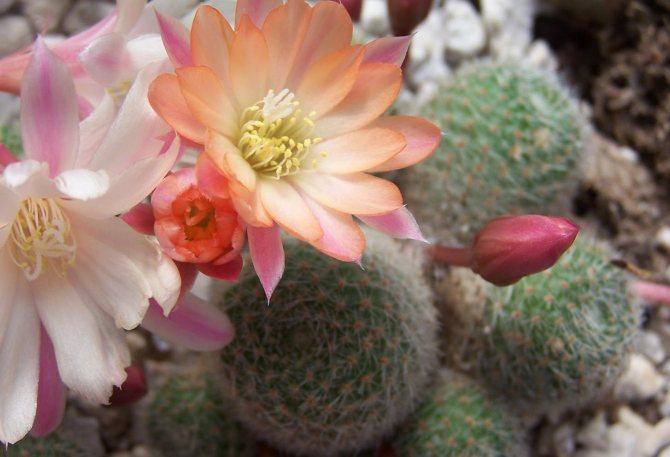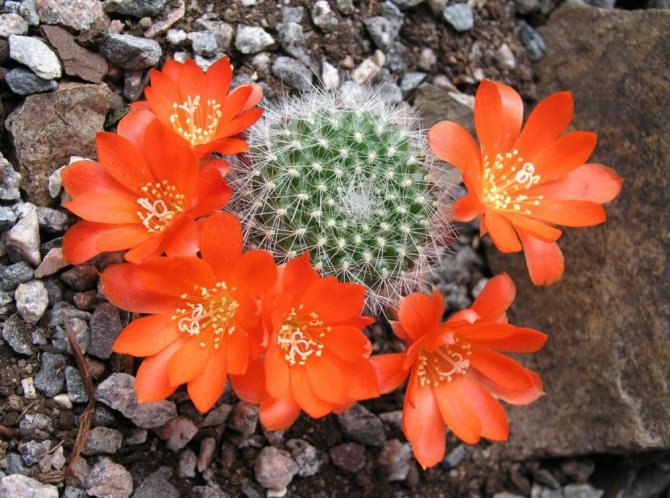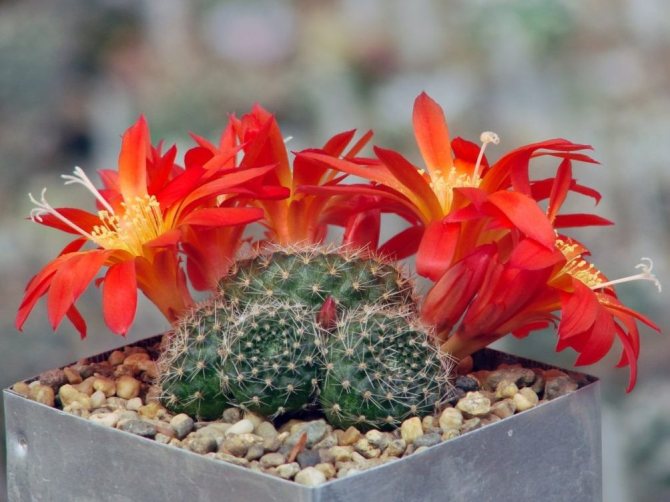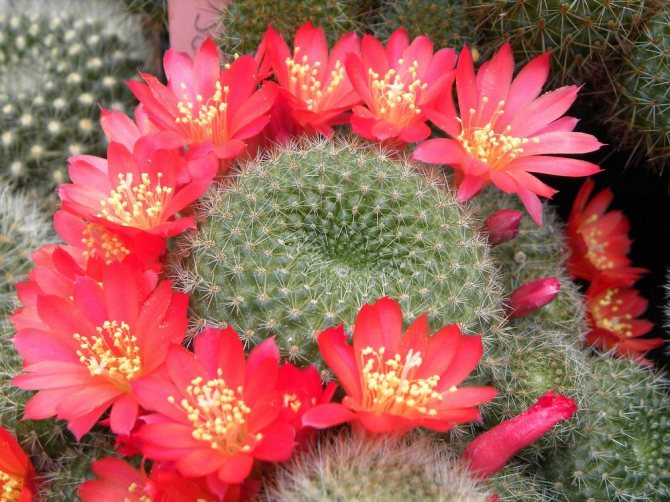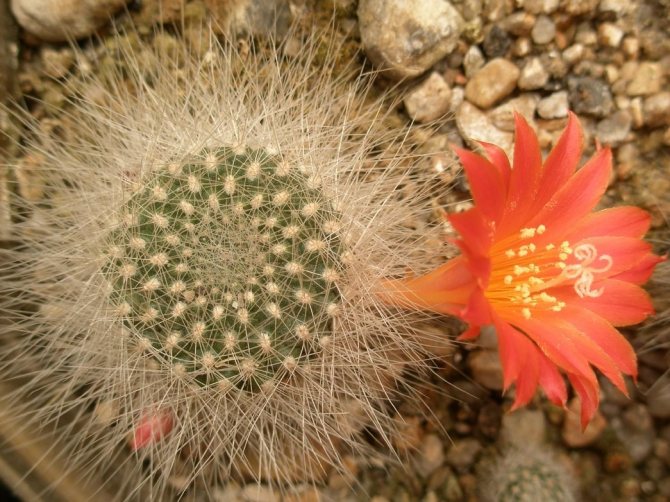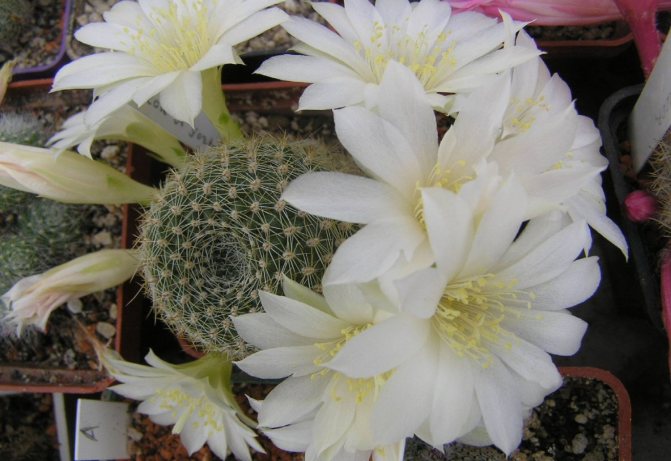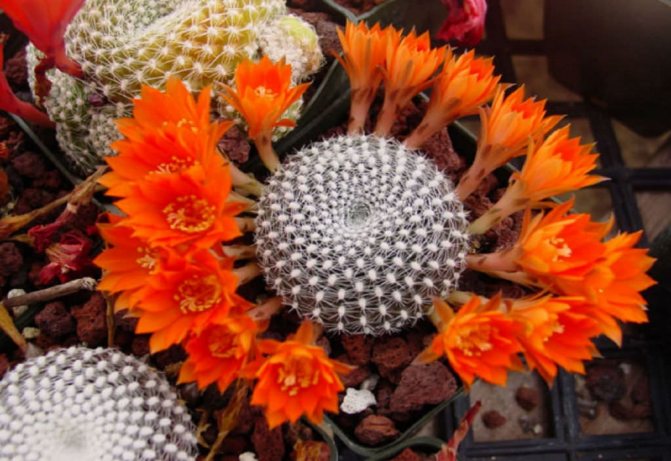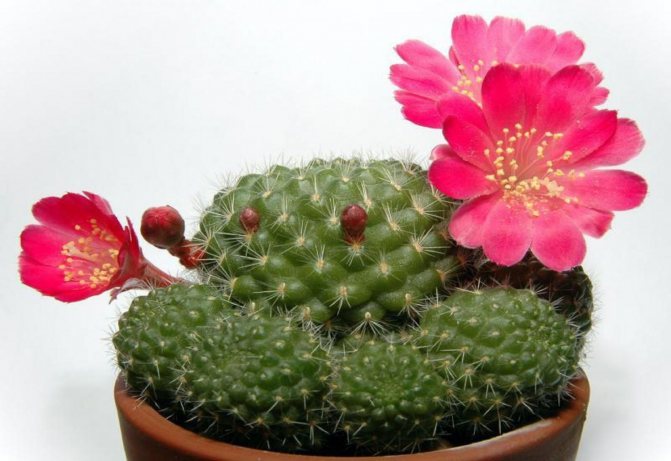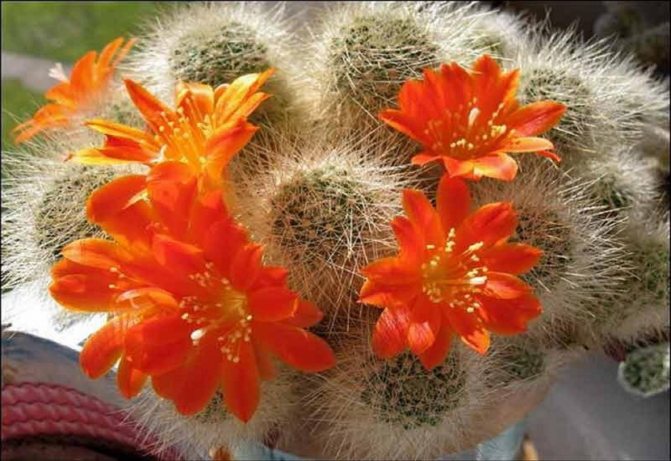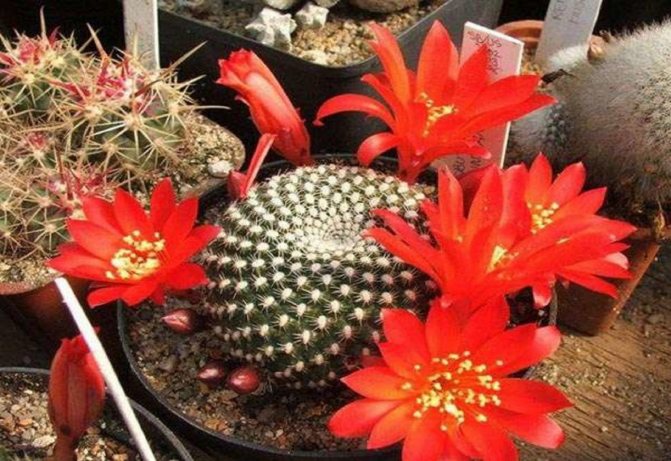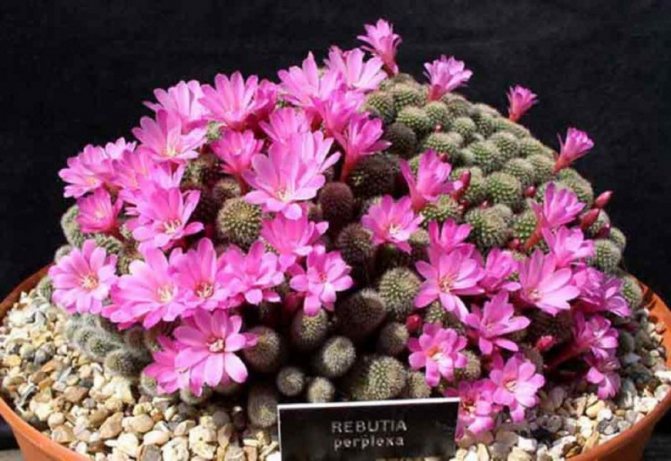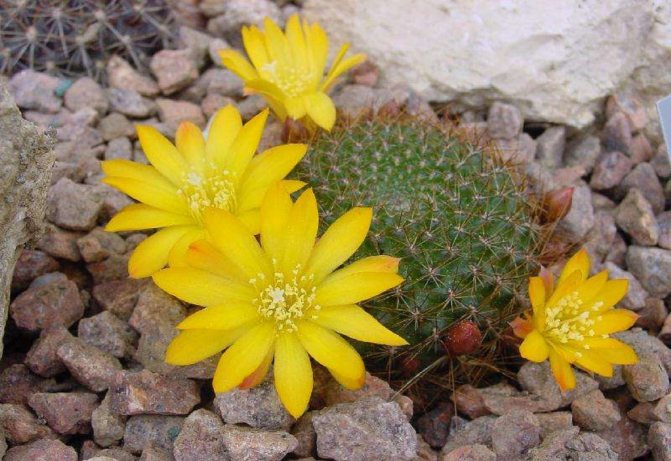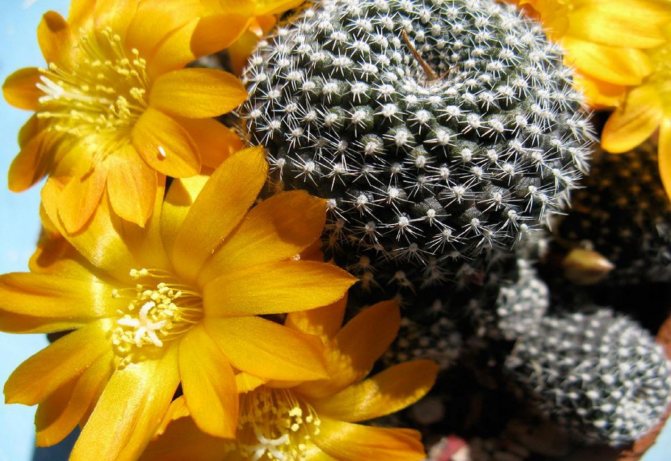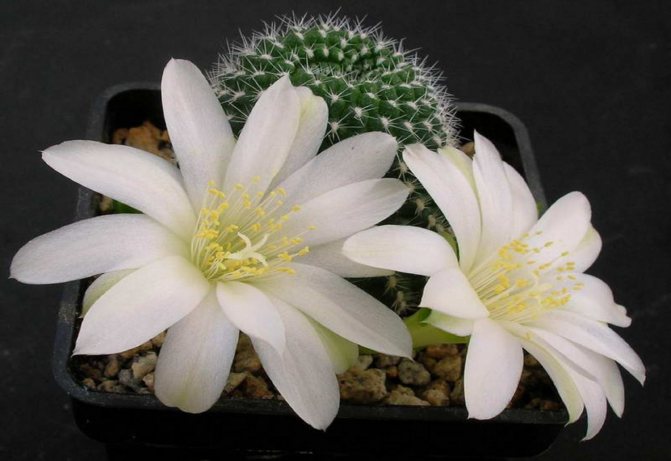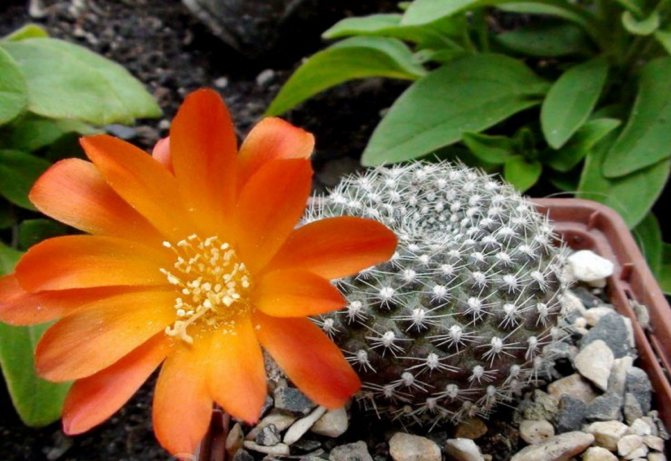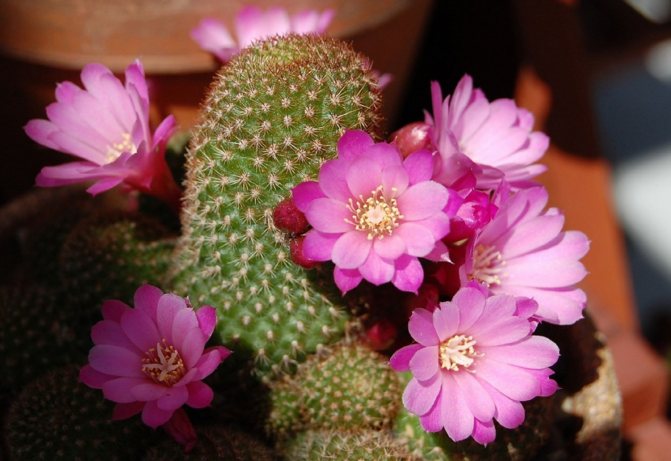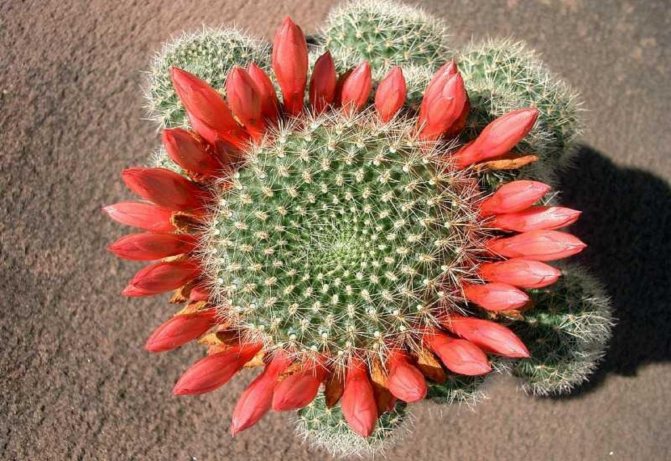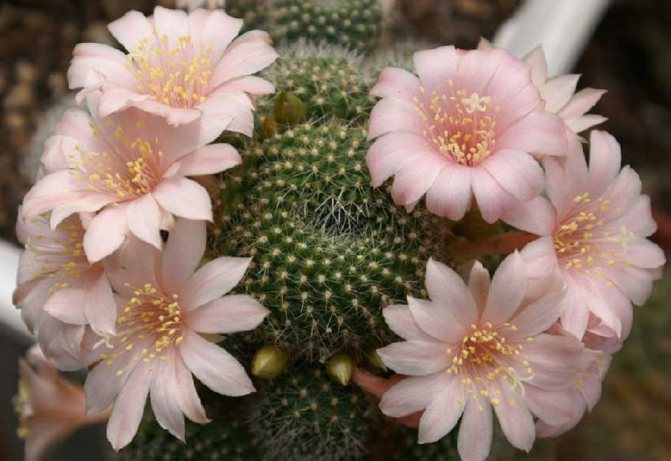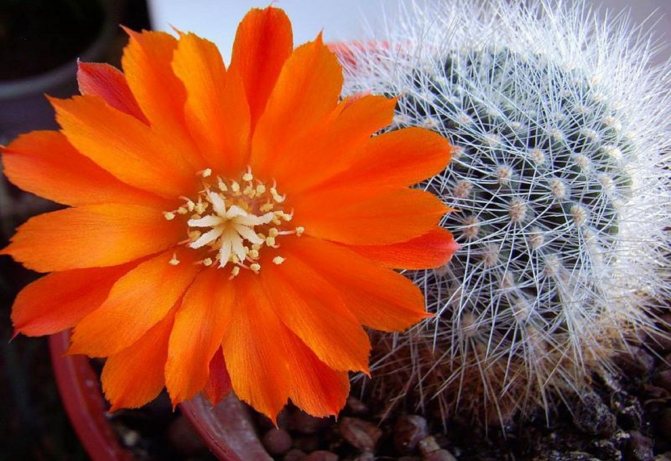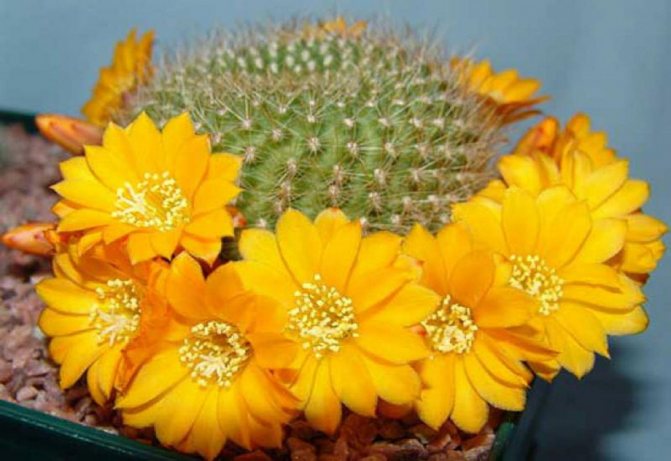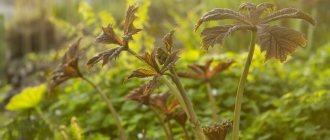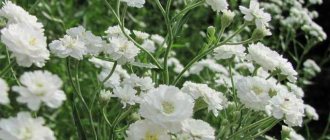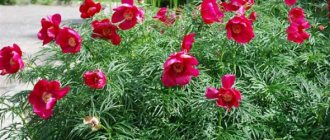The rebutia cactus is one of the most common plants in the world. Its amazing, slightly flattened balls are covered with many bright colors closer to the ground and easily captivate flower growers. The numerous genus belongs to the Cactus family. Its representatives are common in the southwest of South America, and in colder countries are grown as a houseplant.
Botanical description and geography of habitat
The genus Sulkorebutia combines cacti with a characteristic round or slightly cylindrical shape. The tip of these plants is always flattened. Sulcorebutia is a highland Bolivian miniature cactus... Most of the species are native to the province of Cochabamba. Most often, this cactus grows under the cover of other plants - grasses and xerophytic shrubs.
Sulcorebutia develops rather slowly, its spherical stems, solitary at the beginning, form multiple processes with age. The cactus has strong spines, elongated and slightly depressed into the body of the areola, with a short groove extending from them.
The stem color can vary from shades of green to grayish brown. The root system of sulcorebution is powerful and thickened... The flowers are varied, always very vibrant, appear at the top of the stem and often form an attractive wreath. The fruits of sulcorebutia are berries, several millimeters in size.
The first representative of the genus was described by E. Verderman in 1931.
Indoor types of rebution
The genus is very diverse, so it is rather difficult to list all types of rebuts. Breeders are constantly expanding the range and introducing new hybrid varieties. Looking through the catalog with photo rebutions, it is difficult to make a choice, because each copy has a special charm.
Deminute rebution. The plant has a spherical or oblong stem about 10 cm high and 6-8 cm wide. This species quickly forms daughter plants, so the pot is filled with many beautiful balls. The dark green stem has up to 13 spiral-shaped papillary ribs. Areoles have grayish villi and several stiff needles. The spines are 5-6 mm long. In June-July, many funnel-shaped flowers bloom at the base of the stem. Their diameter does not exceed 3 cm. The red-orange petals are slightly bent back.
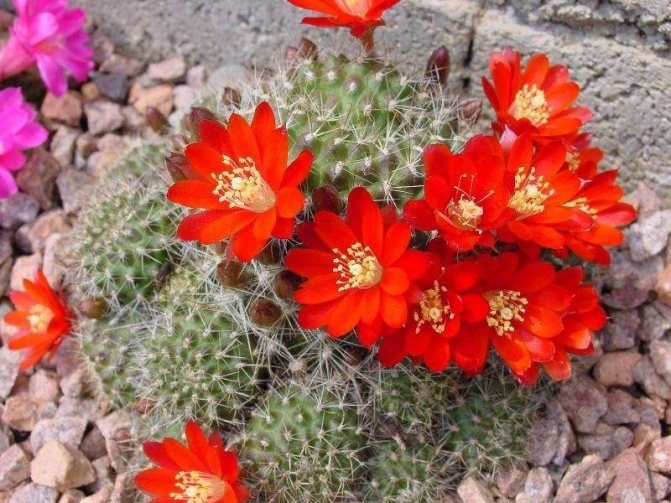
Deminute rebution
The rebutia is tiny. The light green stem in the form of a flattened ball does not exceed 5 cm in height. The papillae on it are arranged in a spiral and are covered with short, bristly spines. The needles are colored silver or golden. The red tubular flowers bloom in June and are 3-4 cm in diameter.
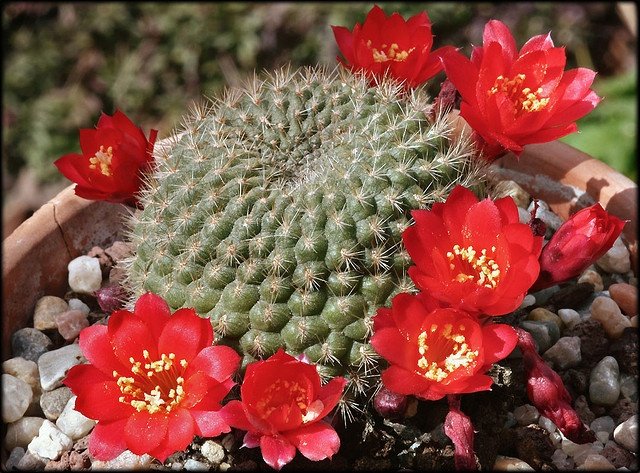

Rebutia is tiny
Albiflora rebutia or white-flowered. The plant forms a dense clump of many whitish balls. Tiny stems are densely covered with whitish pile. Large flowers with a diameter of about 4 cm exceed the size of the stem. The petals are creamy with pinkish edges.
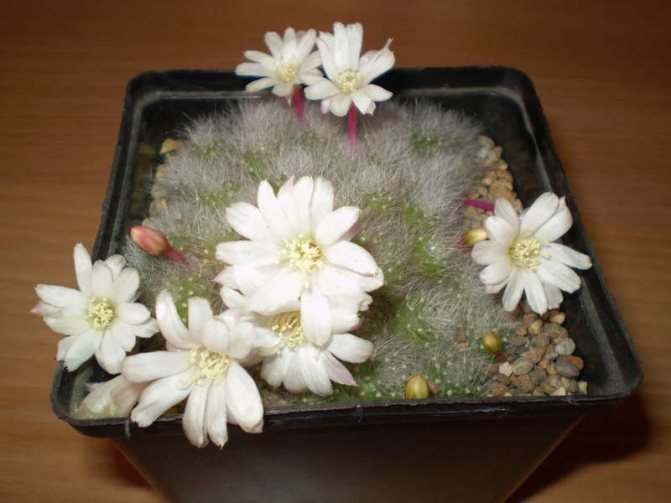

Albiflora rebutia or white-flowered
The rebution is dwarf. The plant has a cylindrical dark green stem. The spines are located on the papillae in bunches and are pressed against the stem.Its base is covered with large tubular flowers with pink or red petals. Flowers open in May.
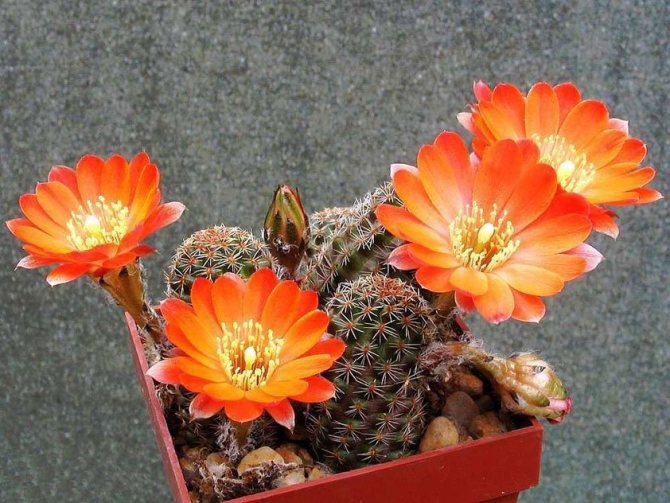

Dwarf rebutia
Senile rebutia. The globular dark green stem reaches a height of 8 cm and a width of 7 cm. Its surface is densely covered with low papillae with numerous whitish spines. The length of the needles is 3 mm. In spring, the plant produces many red flowers with narrow, strongly curved petals.
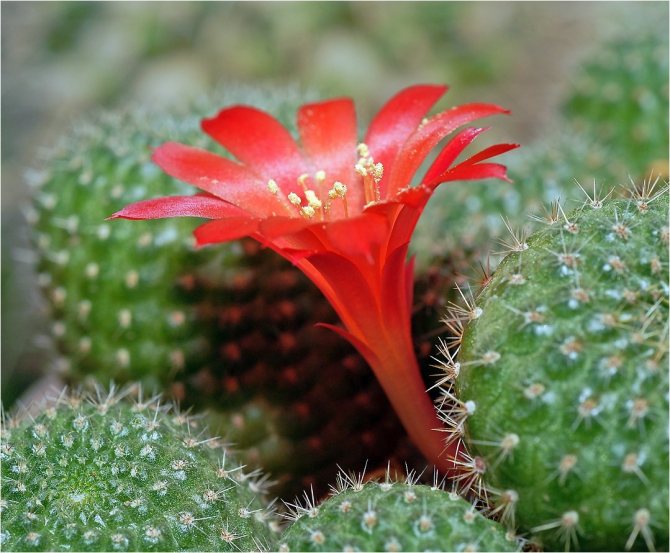

Senile rebutia
Rebuzia caniguerali. The cactus has the best drought tolerance. The small spherical stem is densely covered with very long, hard spines. Several small flowers are arranged in a wreath at the top of the stem. The bells of flowers consist of whitish petals with a bluish border and a bunch of yellow stamens.
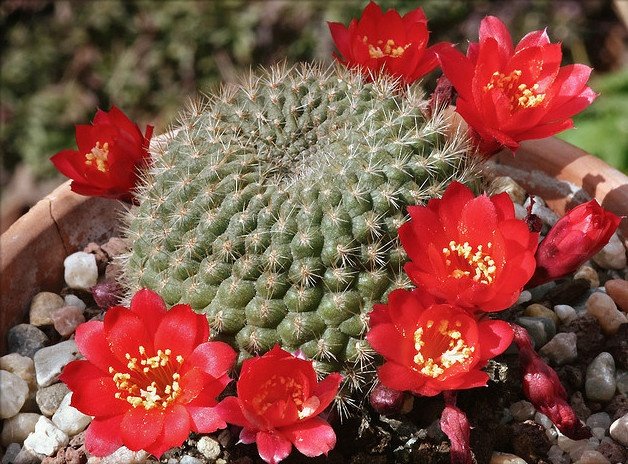

Rebuzia caniguerali
Rebution of the Mansoner. The plant has compact spherical stems covered with spiral ribs. Large canary flowers are located on the sides and bottom of the stems. All the buds open at the same time, turning the curtain into a small sunny island.
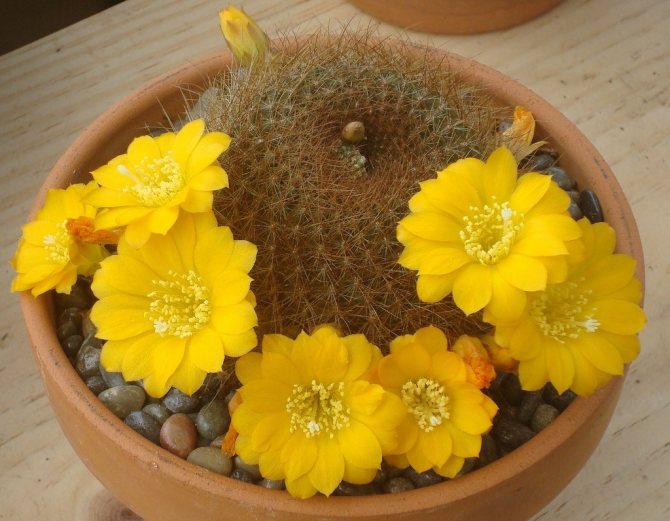

Rebution of the Mansoner
Rebution mouse. The cactus is a few spiny balls up to 5 cm in diameter. The entire surface is densely covered with whitish spines and looks more like a fluffy coat of an animal. Daytime orange flowers have an elongated tube. The diameter of the open petals is 5 cm.
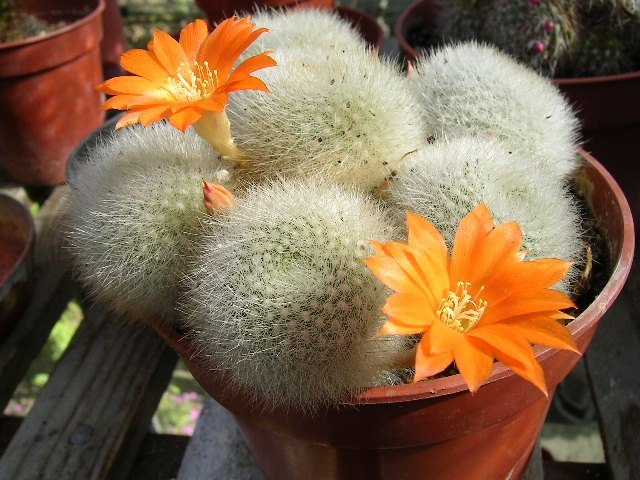

Rebution mouse
Rebution of Krajnz. This species does not form a dense curtain and often grows in the form of a single oblong stem. The low ribs are covered with many tubercles with a short whitish pile and long silvery spines. Scarlet flowers are composed of narrow, swirling petals. The buds are grouped not around the stem, but on one side of it.
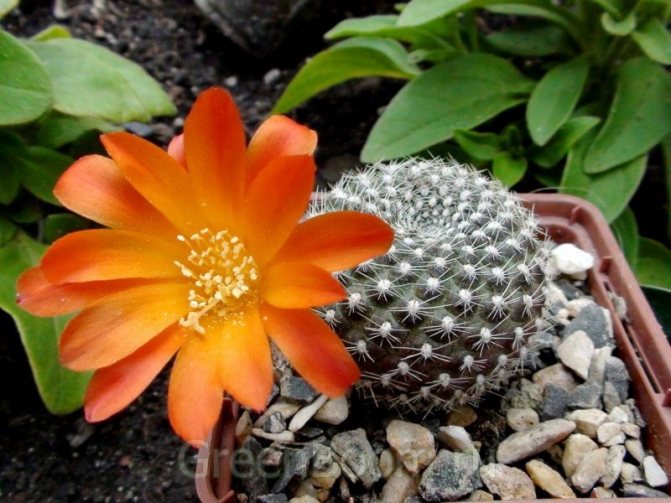

Rebuzia of Krajnza
Popular types and varieties of sulcorebutia
Rauscha (Rauschii)
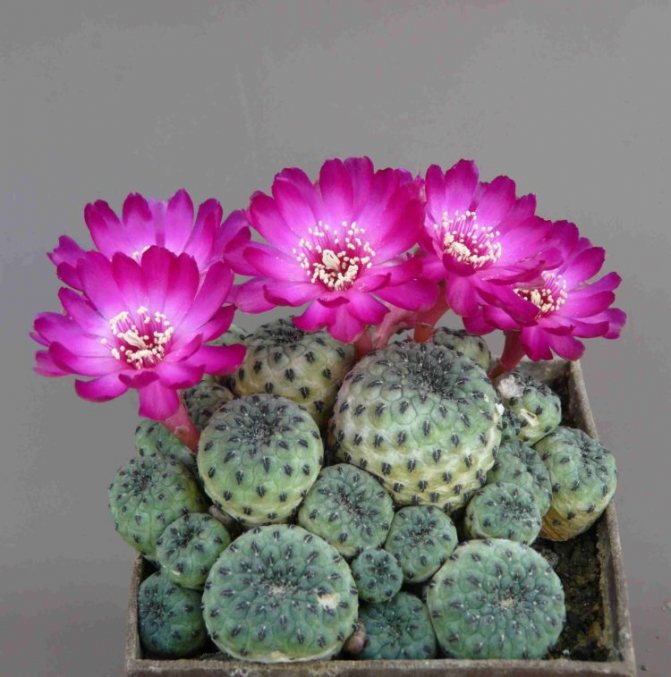

The species was discovered on the tops of the Bolivian mountains by the Austrian cactus expert V. Rausch and named after him.
A plant with a bluish-purple or smoky ruby stem, the top of which is flattened. The stem is overgrown with a large number of lateral shoots, no more than three centimeters in diameter. Sixteen spiral ribs are divided into flat tubercles. Areoles are oblong, with short pubescence. Spines are thin, black, radial, claw-like, adherent, no more than 20 mm in length. There are no central thorns (are there any cacti without thorns?). The flowers are about three centimeters in diameter, brownish-pinkish, with a white center. Inflorescences are tubular, the corolla of the flower is wide open.
Caniguerali (Canigueralii)
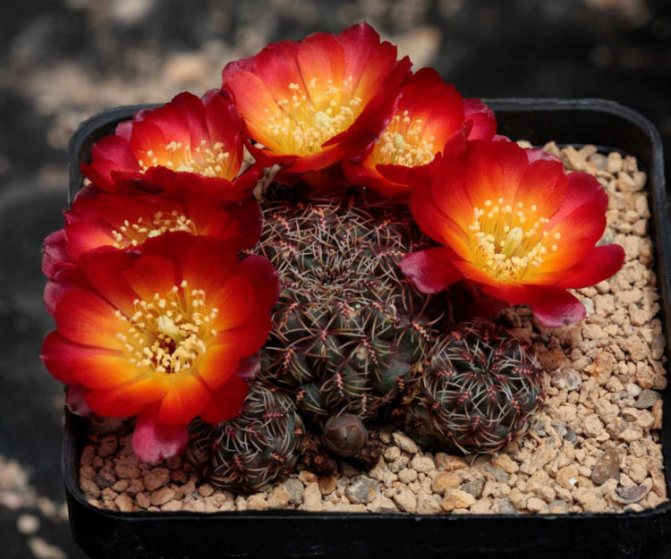

The species is named after the Bolivian priest Juan Cagnigueral... Slow-growing species, variable in color of flowers and thorns. A miniature cactus that forms multi-headed groups.
The stem is no more than three centimeters high and no more than five in diameter, has a depressed top and a color from light green to dark purple. The ribs of the plant are tuberous, spiral. Areoles are narrow, white with pubescence. Each areola has 11-14 thin, bristle-shaped radial spines. The central spines are most often absent, or, if they are, then no more than two. The flowers are wide open, funnel-shaped, of various colors from orange to dark purple, emerging from the lower areoles.
Arenacea
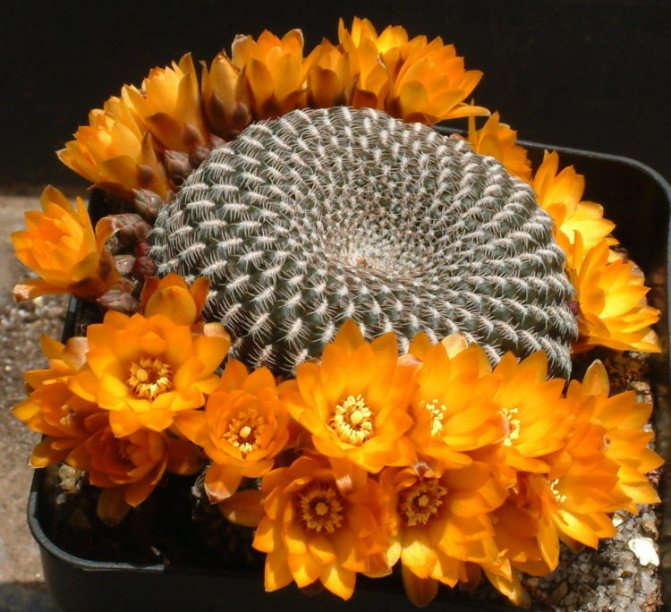

Another name is sandy. A plant with a single stem of a squeezed-spherical shape... The color is greenish-brown, the size is up to 3 cm in length and up to 6 cm in diameter. The apex is depressed. It has about thirty tuberous, spirally located ribs. Areoles are elongated, yellowish-gray, each with 14-16 thin, curved, sometimes confused spines. The flowers are yellow, up to three centimeters in diameter.
Langeri
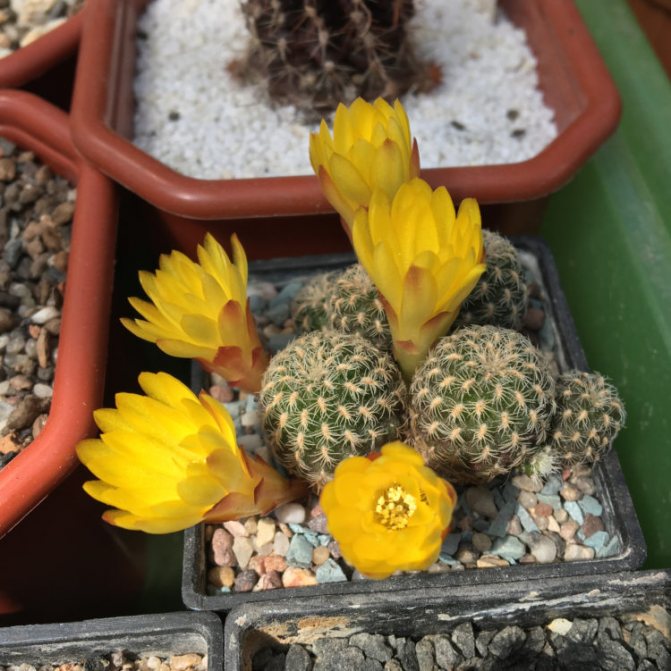

A species with a grayish-green stem, which has ribs divided into tubercles with brown areoles, each of which has 21-25 bristly, comb-like spines.The flowers are funnel-shaped, up to 4 cm in diameter, with numerous, elongated bright yellow petals.
Juckeri
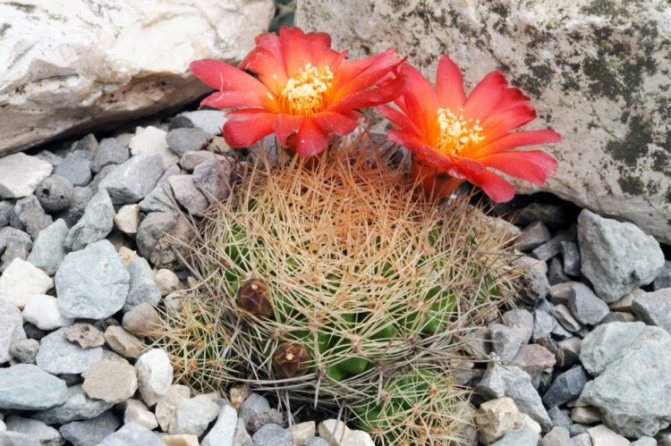

A plant with a stem that grows ten centimeters wide and five centimeters high... Protruding tubercles. Areoles are narrow, up to 6 mm long and about 1 mm wide, with powerful and long straw-colored spines, slightly curving upwards. Flowers with red petals, yellow in the throat area (you can learn about red cacti here).
Steibach (Steinbachii)
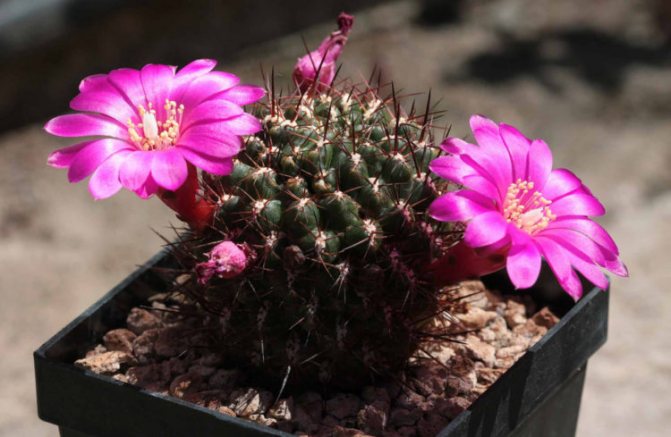

A highly bushy miniature forming large cushions. Stem with green epidermis, divided into flat, oblong tubercles. Areoles are elongated, felt. Each areola has about eight black strong spines, one centimeter long. The central spines, which can be from one to three, are grayish, with a dark tip, up to one centimeter long. The cactus has a large, turnip root. The flowers are funnel-shaped, up to 4 cm in length and in diameter. The color is varied, from raspberry to orange.
Curled (Crispate)
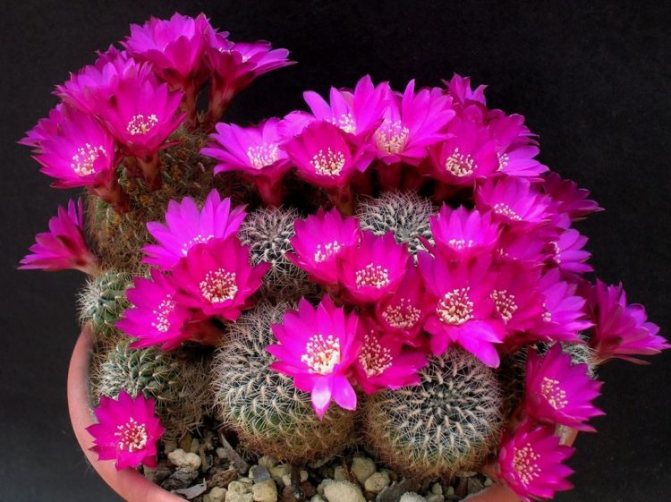

Also called curly or crisp. A spherical stem, two centimeters in diameter, covered with rounded tubercles. Radial spines with a crest adjoining the stem, they are dense, long, light in color. The flowers are pink, about 4 cm in diameter (see about cacti with pink flowers here).
Botanical characteristics
Rebutia is a genus of stem succulents. They grow in meadows among the grass or in rock crevices at an altitude of 3 km. The plant has a thick, long rhizome and round, fleshy stems. There is a small depression at the top of the spherical stem.
Low ribs are arranged in a spiral, they consist of small tubercles. The spines of the plant are short, tough. They are colored silver or yellowish.
Flowers are formed from the lower areoles on the sides or at the base of the stem. The flower has an elongated tube of accrete glossy petals. The diameter of the bell does not exceed 2.5 cm. The petals can be colored cream, pink, purple or scarlet. The core is covered with long yellow stamens. Flowering occurs in April-June. Each flower opens on a sunny day, and rolls its petals at night. Flowering of one bud lasts about two days.
How to take care at home?
- Temperature... In the spring and summer of sulcorebutia, the usual room temperature is 20-25 degrees. If possible, it is necessary to organize the difference between day and night temperatures. In winter, the plant should be kept at a temperature no higher than 10 degrees. It can withstand short-term frost if placed in dry soil.
- Watering... With the beginning of the growing season and swelling of the buds, sulcorebution needs regular watering, in the absence of which the buds will dry out. In the middle of summer, watering should be reduced, spending them as the soil dries out. With the arrival of autumn, watering is again increased for a while and reduced to zero at the beginning of wintering.
- Shine... The plant needs an abundance of light, with a lack of which it stretches and stops blooming.
Intense lighting allows you to preserve the natural shape of the stems, the color of the epidermis and promotes abundant flowering and the normal development of thorns. - Priming... For sulcorebution, you can purchase ready-made store-bought soil, the one that is used for succulents is suitable, if you prepare the substrate yourself, it should contain leafy earth and peat in equal parts with an admixture of gravel chips - up to 40%.
- Trimming... For a highly overgrown plant, formation can be carried out by separating cuttings. Sulcorebutia increases its volume due to actively developing lateral shoots.
- Top dressing... They are fed monthly with ready-made fertilizers for cacti and succulents with a high content of calcium, potassium and phosphorus. Fertilizer should be diluted to half the recommended dose and applied in spring and summer.During the rest period, feeding is excluded.
- Pot... The sulcorebution pot requires a wide and shallow pot with drainage holes.
- Transfer:
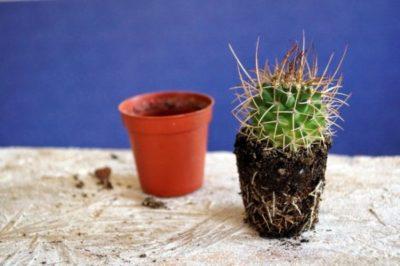

Young plants are transplanted as they grow, and adults are transplanted every three years. - The transplant procedure is carried out in spring or autumn after flowering.
- The plant is removed from old soil, it is very important that the earthen ball is dry.
- Using the transshipment method, the cactus is transplanted into a new container, the soil in which must also be dry.
- After transplanting, the plant is placed in a shaded place and the first watering is carried out only after a week.
- Wintering... Sulcorebutia should overwinter at a temperature of 6-10 degrees, practically without watering. An important point for a plant is the start of growth after a dormant period. At this time, the buds are laid. It is necessary to restrain these processes with low temperatures and dryness until the arrival of constant heat and an increase in daylight hours to at least 13 hours.
Fans of cacti may like materials about various types of cacti: Gymnocalycium, Opuntia, Pereskia, Ripsalidopsis, Ripsalis, Hatiora, Cereus, Epiphyllum, Echinocactus, Ailoster, Ariocactus.
Care rules
At home, caring for a rebution is not difficult at all. Even the plants forgotten for a long time do not suffer and continue to delight the owners with beautiful flowers, which can be seen in numerous photos of the rebutia.
The cactus grows well and forms flower buds in a bright place. He is not afraid of the direct bright sun, but in intense heat, frequent ventilation is necessary to avoid sunburn. East or West oriented windows are preferred. In winter, you can rearrange the rebution to the south side or use a lamp.
Rebutia grows high in the mountains, therefore it is adapted to temperature jumps and cold snaps. It can grow normally in the range of +5 ° C to +25 ° C.
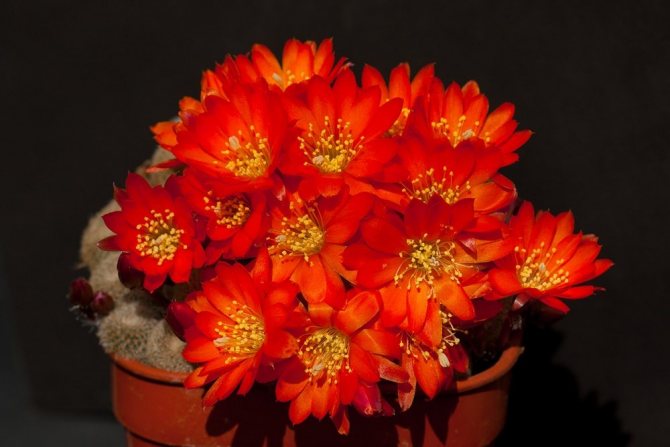

The cactus is rarely watered with small portions of warm water. The substrate should dry well between waterings. With a decrease in air temperature, watering is needed even less often. With excessive watering and dampness, the rebutia will begin to suffer from rot. Humidity does not matter much, but in winter it is worth moving the pot away from hot batteries.
In April-August, watering is combined with top dressing. Use a special fertilizer for succulents with a minimum nitrogen content.
Sometimes mealybugs or red mites can be found on the stems. For parasites, insecticide treatment should be carried out immediately. Re-spraying is performed after 5-7 days.
Features of outdoor care
- Outdoors, sulcorebution should be placed in a sunny location.
- The landing should be protected from northerly winds.
- Every year, the soil under the cacti must be changed, at least partially, and all weeds must be carefully removed.
- Watering is carried out in the event of a prolonged absence of rain. The water should be soft, not from a well.
- Around the cactus meadow, you must carefully mow the grass.
- If the temperature drops to ten degrees, the cactus is dug up and transferred for wintering indoors.
Pests and diseases
Most often, rebutia is invaded by spider mites. These are small insects that can cause irreparable harm to the health of the plant. They feed on the sap of the cactus, as a result of which it loses its energy. This leads to the fact that the plant slows down its growth and stops flowering completely.
The spider mite is rather small and invisible to human eyes. However, there is a telltale sign that this type of insect has wound up on the surface of your plant. He is able to leave behind a white web that you will immediately notice.
Also, improper watering or poor care can affect cactus diseases. Often, gardeners' mistakes lead to the fact that their plants suffer, therefore it is recommended to carefully study all the requirements of flowers before buying.Excessive watering and excess liquid can cause rot to form on the surface of the cactus.
At first, these are small brown spots, which usually do not frighten gardeners, but in the end this leads to the fact that the plant dies. In addition to the fact that rotting occurs on superficial areas, it can also affect those that are not visible at first glance. We are talking about the root system of a cactus, which is also subject to rotting.
Now read:
- Choosing cucumbers for open ground according to your preferences
- Exquisite junkus (sitnik) spiral in the interior
- Do-it-yourself correct cultivation of adenium succulent
- Description of 12 types of late varieties of cabbage for planting
About
Agronomist of the state agricultural enterprise "Garovskoye" of the Khabarovsk region of the Khabarovsk region.
Propagation by seeds and side shoots
- Seeds:
- For sowing seeds, you need to choose flat, wide containers.
- Before planting, the seeds are soaked for a day in a weak solution of potassium permanganate.
- The seeds are scattered over the soil surface and slightly moisten the substrate.
- The container is covered and left in a bright place at a temperature of 15-20 degrees.
- After the sprouts appear, you need to wait until the height of their stem reaches 2 cm, from that moment they can be transplanted into small pots.
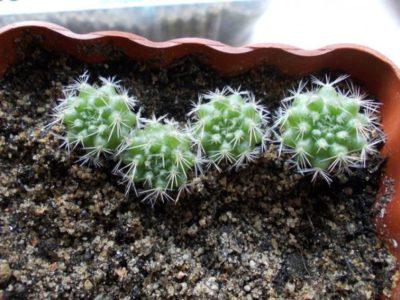

Side shoots... As it grows, sulcorebutia produces many “babies”.- Lateral shoots are separated by performing a slight twisting motion with the hand. For the procedure, be sure to wear gloves so as not to damage the skin with thorns.
- The resulting planting material is placed in a dry substrate for cacti.
- The plant should take root in dry soil, after this happens, the sulcorebution begins to be watered with a syringe or pipette.
Plant transplant
Small containers are selected for rebutia, so a highly branched plant will have to be transplanted often, every 1-2 years. Use shallow wide pots with large holes and a thick drainage layer. The soil for rebutia should be neutral to weak acidity. You can buy ready-made soil mixture for cacti or make it yourself from the following components:
- sod soil;
- charcoal;
- leafy soil;
- granite chips.
Cacti are transplanted in the spring using the transshipment method so as not to harm the roots. It is recommended to separate curtains that are too thick.
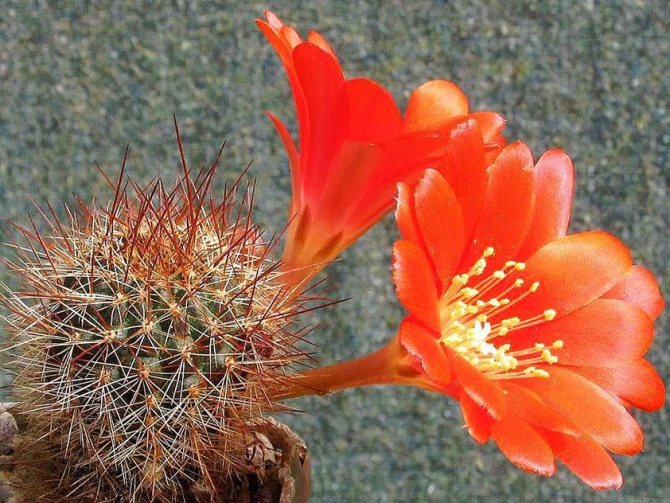

Diseases and pests
- Like all cacti, sulcorebutia rots with improperly organized drainage and moisture stagnation.
- The elongated stem of the plant indicates insufficient lighting.
- If the cactus is exposed to direct sunlight for a long time, it can get burned.
- The red spider mite is dangerous for sulcorebutia. This pest is difficult to notice with the naked eye; it detects its presence by the appearance of light dots on the skin of the stem. With a massive accumulation of parasites, you can observe the cobweb covering the plant.
The pest is destroyed with the help of insecticidal preparations.
How does leaving
Rebutia is used to growing in fairly dry areas and therefore is not too demanding to care for it. Her homeland has unusual weather conditions for our country, so carefully study this issue before buying a rebution. It rains constantly in winter, and it is quite dry and hot in summer. Before purchasing such a plant, read the information on caring for it and its preferences.
Popular: Absorb radiation by indoor cactus Gymnocalycium
Lighting and optimal temperature
The rebutia cactus is a fairly light-loving plant, so you better place the pot with it on the windows with a south orientation. This is because this side always receives the most sun. Make sure that the rebution is not exposed to direct, scorching sunlight.This can negatively affect its growth, in some cases the plant may even get burned.
This is a rather unpretentious plant in temperature conditions, as it is accustomed to constant heat. Leaving it in the room, you can not worry about the rebutia freezing. When winter comes, you can remove the pot from the windowsill and place it on the table. This is done due to the fact that some gardeners are afraid of the negative impact of drafts on the plant.
Watering and moisture levels
Regular watering several times a week is recommended. The water for irrigation must be allowed to settle for 24 hours, pay attention to the fact that the liquid must be warm. Do not leave the flower unattended, make sure that the soil in which it grows does not remain dry.
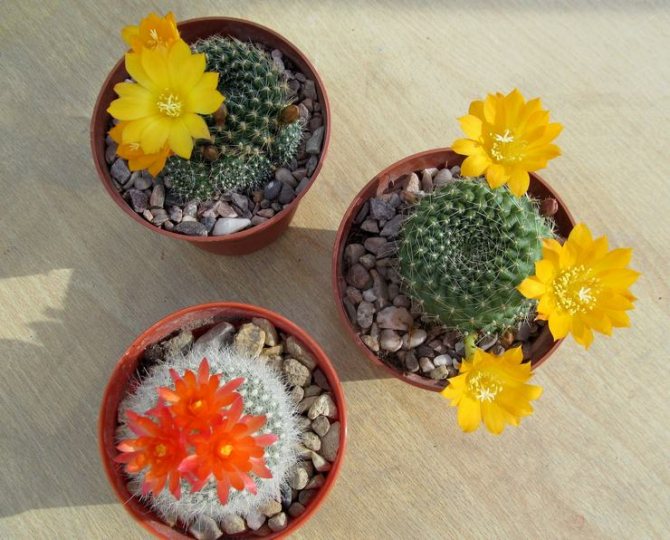

The type of plant is not used to being in permanently dry soil. Be prepared for the fact that rebutia does not require a lot of fluid during the cold season. Therefore, in winter, you can practically stop watering or reduce the amount of water. Intensive watering at cold temperatures can cause rot on the plant.
Be careful, this type of cactus does not respond well to additional moisture. Therefore, in the room where it is located, you should not keep air humidifiers or perform this procedure yourself. At high temperatures in the rooms, you can spray it with a small amount of liquid once every two weeks. It is recommended to do this if the room temperature is more than 40 C.
Fertilization
Rebutia responds well to the introduction of a variety of feedings that help its intensive growth and improve its health. It is recommended to use mineral species as a fertilizer, it is they that saturate the root system with useful trace elements and vitamins. As a result, this leads to the fact that the plant is renewed, its color becomes more saturated, and the flowering is more dense. The fertilization period begins in late spring or early summer, and can last until autumn. Stop any feeding in winter. At this time of the year, the plant needs peace and therefore it is not worth disturbing it once again.
Popular: Terrible types of ferocactus varieties for indoor cultivation
Similar flowers
Externally, Sulcorebutia is similar to:
- Rebutia (you can learn more about the Rebutia varieties here);
- Lobivia;
- Echinopsis;
- Mammillaria;
- Astrophytum.
Despite their long and widespread use as a house plant, cacti will never become ordinary inhabitants of the house. In particular, growers claim that there are no two identical sulcorebutias in the world, therefore, you can safely stop your choice on this plant, if you wish, you can get an original living element of the interior.
If you find an error, please select a piece of text and press Ctrl + Enter.
How does reproduction take place
Rebutia is propagated in two ways: by seed or cuttings.
The seed method is quite simple, start sowing seeds in late fall. To do this, prepare a long container in advance, where they will be located and the ground. The soil can be mixed with a little sand to make the plant more comfortable. Sow the seeds so that they are on the surface of the ground. From above, it is recommended to cover the container with glass or film to create a greenhouse effect.
The temperature and humidity necessary for intensive growth will be stored inside. After approximately one week has passed since planting, the top coat can be removed. As seedlings will have three branches, they can be planted. Place the rebuilt pots outside periodically to get oxygenated.
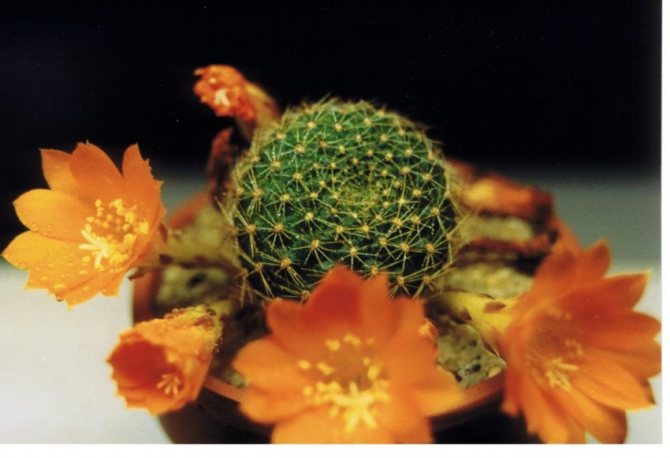

Propagation by cuttings is simple and usually does not take much time. The rebution has many branches that do not fall away. To propagate with a knife, cut off the branches and place them in a pot of soil.Within one month, the plant will begin to take root and, subject to all the rules for care, will begin to grow rapidly.
Reproduction
Rebutia reproduces in two ways:
- When the fruit bursts, the black seeds are harvested. It is better to plant them in early March on moist soil, without falling asleep on top of the earth. Then the pot must be covered with foil, leaving the temperature at about 20 ° C. The film must be removed every day for two to three minutes for airing. During the first year of life, the cactus should not be placed where there is a lot of bright sunlight, just as the soil should not be allowed to dry out.
- The plant produces lateral shoots - "babies". They are separated from the cactus and planted in dry soil or sand. With the appearance of sprouts, watered with a pipette.
Growing conditions
Illumination
It is better not to allow direct sunlight on the plant, for young cacti this is especially harmful. Ideally placed on an east-facing window. An adult plant can be placed on the southern windowsill; in winter, move young plants there. With a seasonal decrease in the amount of natural light (from late autumn to March), turn on phyto-lamps or fluorescent lamps.
Air temperature and summer walks
It is useful to spend the summer season of rebutia outdoors - put it on the balcony, veranda, or dig in with the pots in the garden. If this is not possible, try to ventilate the room more often.
In spring and summer, it calmly tolerates room temperature. During the winter months, it is advisable to keep the plant indoors where the air temperature ranges from 6-12 ° C.
Possible growing difficulties
Rebuts are in good health and only get sick with improper maintenance and serious disturbances in care:
- The stems are covered with pale spots - a sign of infection of the cactus with mealybugs. The plant should be isolated and treated with soapy water or insecticide.
- Decrease in decorativeness - occurs against the background of a decrease in air humidity, when dust accumulates on the stems. You need to spray the flower.
It is dangerous to overflow the soil, in this case the cactus can rot starting from the root system. In this situation, you can try to save the flower by treating the rhizome with a fungicide and planting it in fresh soil.
Growing rebutia from seeds
In nature, rebutia reproduces superbly by self-sowing: the fruit cracks, the seeds fall to the ground and germinate, and soon small cacti appear near the mother plant. Florists use this method extremely rarely, because the seeds are small and not very convenient for sowing, they also need to be purchased at a flower shop.
The procedure includes the following steps:
- Fill wide containers with an earth mixture prepared on the basis of 2 parts of sod land with the addition of 1 part of sand and the same amount of peat;
- Level the soil surface and spray with a fine spray;
- Mix the seeds with fine sand for easy sowing and spread over the soil, as if you were pouring salt into a dish;
- Provide diffused lighting and an air temperature of at least 22 ° C;
- The seedlings will be very thick, thin them out with tweezers;
- When the senses grow up to a height of 2 cm, they can be seated in separate containers.
Planting and caring for rebution
- Bloom: from the second year of life, under good conditions, it can bloom throughout the year, but the cactus lays flower buds at the end of February.
- Lighting: bright sunlight throughout the year: southern windowsills are most suitable.
- Temperature: during the growing season - common for living quarters, but in winter a cooler content is needed - 8-12 ºC.
- Watering: regular and even: in the summer - once a week, but in extreme heat, the substrate will have to be moistened more often. In winter, watering is almost completely stopped, especially if you are interested in the appearance of children.
- Air humidity: usual.
- Top dressing: from April to September - once a month with complex fertilizer for cacti.The nutrient solution is added to a pre-moistened substrate.
- Rest period: not pronounced, but usually within 1-1.5 months after flowering.
- Transfer: in March, as needed, when the roots have mastered the earthen lump.
- Reproduction: sometimes by seeds, but more often and easier - by lateral shoots (children).
- Pests: sometimes affected by red spider mites, scale insects and mealybugs.
- Diseases: stem rot and cork growths.
Read more about growing rebutia below.
Similar plants
If you want to acquire similar plant species to create a thorny and blooming collection, you should pay attention to:
- Astrophytum is a larger species of cacti that blooms with white or yellowish-white inflorescences;
- Echinopsis is another vast variety of flowering cacti;
- Gymnocalycium is a succulent plant with large flowers up to 10 centimeters.
general information
The genus of cactus rebutia consists of 41 species; these plants are found naturally in Bolivia, Peru and Argentina. Many representatives of the genus were in demand in indoor floriculture due to their small size, undemanding and vitality. And besides, they, unlike most cacti, willingly bloom when grown indoors.
The most difficult to grow at home are mountain varieties of rebucius, which used to belong to the genera of Reicheocactus, Weingartia and Sulcorebutius. Most often they are bred by experienced succulent growers familiar with the features of such vegetation.
But, most of the rebuts are so unpretentious that they can grow for a long time in tight containers filled with poor soil.
In the summertime, pots with these plants can be dropped on the garden or backyard, but they should be protected from the scorching midday sun rays, which can leave burns on the leaves.
Varieties
The number of species remains controversial due to differences in the definition of genera. In 2001, botanist Anderson recognized 41 species, but since March 2013, the list of plants (formed by the Royal Botanic Gardens) has accepted only 12 varieties of succulents.
Here are the main types, description.
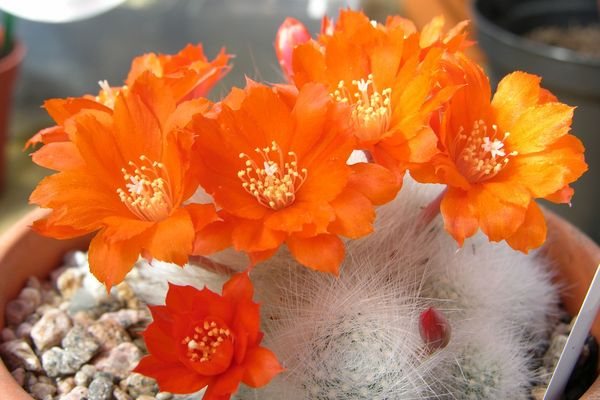

Rebutia minuscula
Consists of spherical stems up to 5 centimeters in diameter, the stems form large associations. The stem has 16–20 ribs with small but distinct tubercles. Each areola produces 25–30 thin, whitish spines.
The photo shows that flowers are formed around the base of the rebutia. They are red in color, up to 4 centimeters long. Some classifications include varieties with yellow and orange flowers.
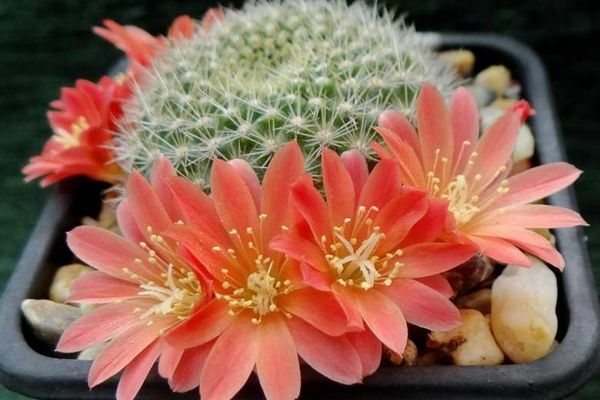

Violet-flowered rebutia (Rebutia violaciflora)
A type of succulent with yellowish-golden thorns about 25 mm long and a yellow-green spherical body. Stems are hemispherical or spherical, small, usually less than twenty millimeters in diameter. The ribs are divided into flat, rounded, and spiral tubercles. There are about 20 thorns. Flowers are funnel-shaped, 30–35 mm long. Their colors range from light purple to reddish.
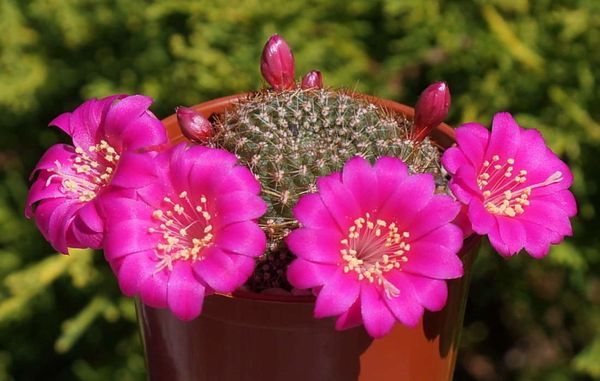

They tolerate winter well if kept dry. They require a sunny location: from a lack of lighting, the stem is strongly stretched.
Rebutia marsoneri
The stem of the succulent is covered with dark brown spines. This cactus is harder than other species to tolerate sudden changes in temperature. The flowers are funnel-shaped, mostly yellow or reddish.
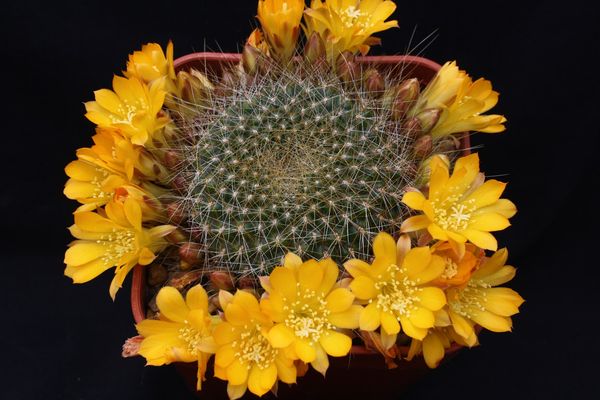

Reproduction of rebuts and ailoster
These flower-crowned cacti multiply easily due to constant growth and tillering. Ailosters and rebuts allow you to freely separate the side shoots and plant them as independent specimens for rooting in a standard substrate. Such "babies" grow rather quickly and themselves give a large offspring, for several years "catching up" with the mother plant.
Ailosters can also be obtained from seeds.They are grown in a mixture of sand and substrate or stone granules and substrate, with top drainage, supplementary lighting for 2 years. Sowing is best done in wide low bowls, spreading the seeds at a distance of 2-3 cm so that there is no need to dive and "touch" young plants. For germination, a stable temperature of about 25 degrees is needed.
Possible problems
The Rebutia cactus is generally unpretentious to different conditions of detention, but when cultivating it, the following problems may arise:
- With an excess of nitrogen, especially with a simultaneous deficiency of potassium and phosphorus, the roots of the succulent begin to rot. You need to notice this problem only during the transplant. If the process goes to the trunk, the lower part of it becomes brownish, watery, the plant may tend to the ground. In the first stages, if a problem is detected during transplantation, the damaged roots must be removed, the root system must be treated with a weak solution of manganese, dried in the air for a couple of days and transplanted into new sterile soil and a clean pot. If rotting has spread higher, the plant is propagated by children or shoots from seeds.
- Pests and diseases rarely damage the flower. On contact with diseased plants, Rebutia can become infected with mealybugs. It leaves pale spots on the surface of the stem. To eliminate pests, the entire surface of the plant is treated with karbofos mixed with water or soapy water.
- If the cactus looks lifeless, its decorative effect has been lost, it may lack moisture. Succulents accumulate in the trunk of water not only with the help of the root system. Most cacti extract water from the air, assimilating it with pubescence or halos, in which thorns are placed. If the entire surface of the trunk is covered with a thick layer of dust, water absorption is reduced, and the Rebutia suffers from dehydration. To fix the problem, moisturize the plant regularly by showering or spraying.
The miniature spherical succulent Rebutia is often used not only as an independent flower, but also in florariums, decorative flower compositions. It complements taller cacti and indoor flowers well.
Description of the cactus rebutia
The stems of the rebutia are spherical, covered with many spiny needles, ribbed. Cacti are considered undersized, as they grow no higher than 6 cm, less often they grow up to 10 cm.The ribs located on the stem are weakly expressed, arranged in a spiral and separated by tubercles, there are at least 11 ribs on one stem. Due to the fact that the cactus has many thorns, it looks like a fluffy ball. The spines can grow from 5 mm to 3 cm. The flowers are large, shiny, wide open, funnel-shaped. Cucumbers are orange, orange-yellow, red and orange-pink.
What to do after flowering?
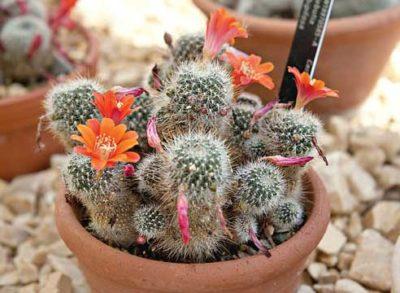

After the flowering of Rebutia, fruits are formed in the form of berries, containing a large number of seeds. You can wait for them to ripen in order to collect seeds for self-cultivation of new plants, or leave them on a cactus. Over time, they spill out on their own and germinate next to the mother plant, forming whole seedling colonies.
After the end of the flowering period, if necessary, the plant can be transplanted. If transplanting is not required, then the cactus should be placed at a temperature suitable for wintering to ensure flowering next year.
Photo
The photo shows what a cactus called Rebutia looks like.
The rebution is tiny.
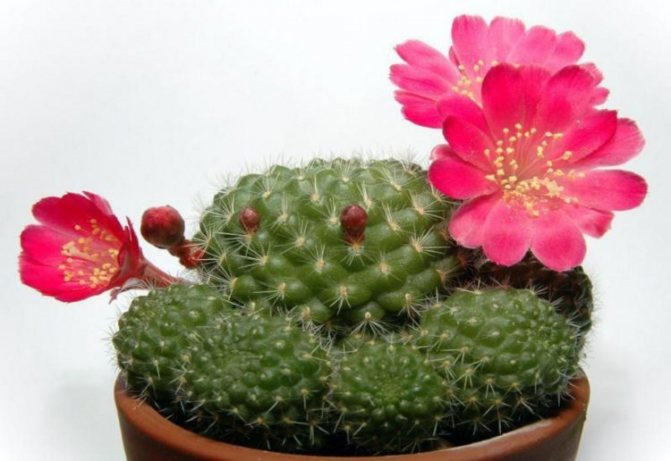

Senile rebutia.
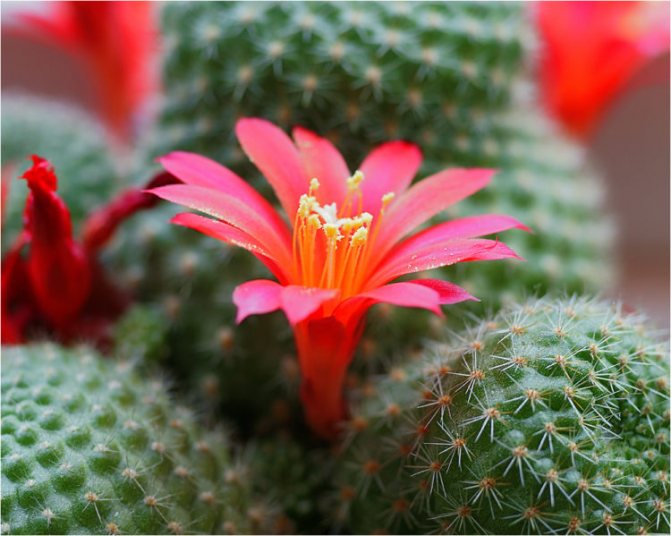

Rebution of Marsonera.
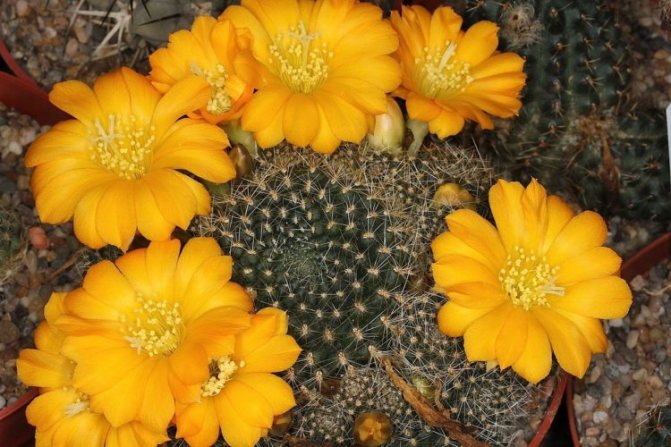

Rebution is Beautiful.
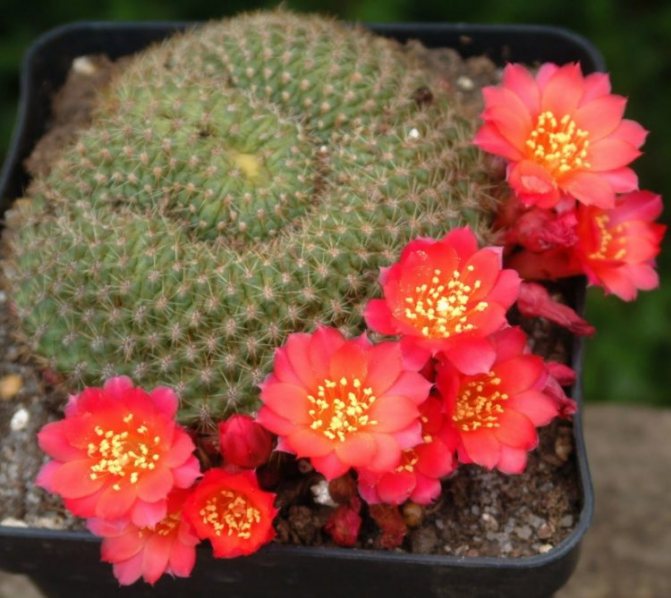

Ritter's rebution.
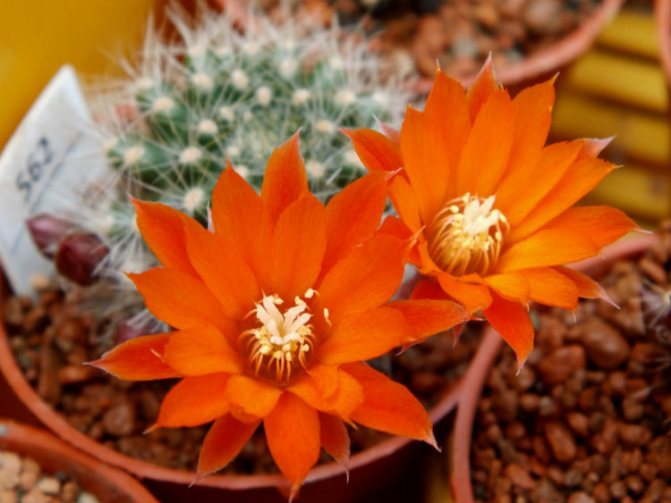

Since there are a lot of different types of cacti, we have prepared for you information about mammillaria, prickly pear, perescia, ripsalidopsis, ripsalis, hathiora, cereus, epiphyllum, echinocactus and ailoster.
Rebuts that almost swallowed the Ailosters, and their similarities
Cacti are considered to be plants that are found in every home.Every florist who has grown a cactus at least once must have dreamed of its magical bloom. Beautifully flowering cacti are often considered capricious and demanding plants. But you can’t say the same about some of the most spectacular flowering species - about rebuts and very similar to them Ailoster. These cacti have rightfully earned the title of unpretentious beauties. And they are strikingly similar to each other, not only in appearance, but also in their requirements for wintering and growing conditions in general.
Before getting acquainted with isosters and rebutions, it is worth learning about the confusing and still unclear classification of these species. The roots of the confusion are in the changes in botanical classifications, due to which, at the beginning of our millennium, the beautiful flowering cactus Aylostera was already included in the rather big genus of rebuts, and then, apparently, they changed their minds, but not quite.
Rebuces and Ailosters are so similar in appearance to each other that it is easy to understand why scientists have so many difficulties with definitions. Plants have always been considered separately, but in 2001 the birth Ayloster (Aylostera) and Rebutia (Rebutia) were merged.
The abolition of the independent genus Ailoster gave rise to a lot of controversy, and their result was a revision of the classification a dozen years later: in 2009, authoritative publications again “separated” the Ailoster, and five years later these cacti received a controversial status. Since no final decision has been made, their “unresolved” status continues to create even more naming difficulties.
True, all these retraining had little effect on the practical side of cactus studies. Most of the cacti, which are either really now more correctly called rebutions, or still not, are found on sale under the name Ailostera. Even in professional catalogs and at exhibitions, familiar views can often be found under the old and familiar name.
So both names - ailoster, rebutia, and even rebutia, can be fairly used as synonyms. After all, the botanical name does not affect the fact that these cacti are easy to recognize in any cluster of fellows. As well as the fact that it is not easy even for experienced florists to distinguish between rebuts and ailoster. These are such similar plants that they can be viewed together.
Rebuts and ailosters are flowering cacti, distinguished by a special tendency to overgrow, the formation of children, and dense constant tillering. Stunted and easily recognizable by their almost perfectly rounded shape, these cacti are spherical stars, although a spherical-cylindrical shape is also found among some rare representatives.
The maximum height of ailoster is limited to 10 cm, but most often they and rebuces do not grow higher than 5-6 cm. The diameter is also limited to 6 cm. The ribs are weak, low, divided into small tubercles, the latter most often arranged in a spiral. The minimum number of ribs is 11. Spines in Ailoster and rebucias are heterogeneous, but there are a lot of them, and, as a rule, they are very thin, bristle-like, about 0.5 cm long for radial spines and up to 3 cm for central ones. In one areola, you can count up to 30 thorns, due to which the entire cactus looks patterned and fluffy at the same time.
Blooming rebucias and ailoster
Where rebuts and ailosters really do not know equals, it is in pomp. Few competitors can compete with them on this basis. Due to the fact that the flowers bloom from the areoles only on the lateral surface of the stem and most often closest to the bottom, the cactus seems to be putting on a floral wreath. The flowers are large enough, solitary, sit on pedicels that stand out in their length, funnel-shaped, open wide.
At first glance, it is not easy to distinguish a blooming Aylostera from a rebutia. The only difference is in the details, which you will have to look at: in the Ailostera, the pistil is half fused with the tube, and the tube itself with the ovary is covered with hairs.But both cacti have glossy, bright flowers, they open only in clear weather and close at night, last at least 2 days and surprise with the beauty of bright yellow stamens.
Rebuces and ailosters bloom most often in the second, but definitely - in the third year. Most often, these cacti bloom in summer, but under optimal conditions they are able to bloom not once, but twice. And the timing of flowering in some species is shifted to spring.
Ailosters are often referred to as solar cacti. But this statement is quite suitable for all rebutions. These cacti bloom advantageously in a fiery range, offering orange, yellow-orange, orange-pink and pure reds to be admired.
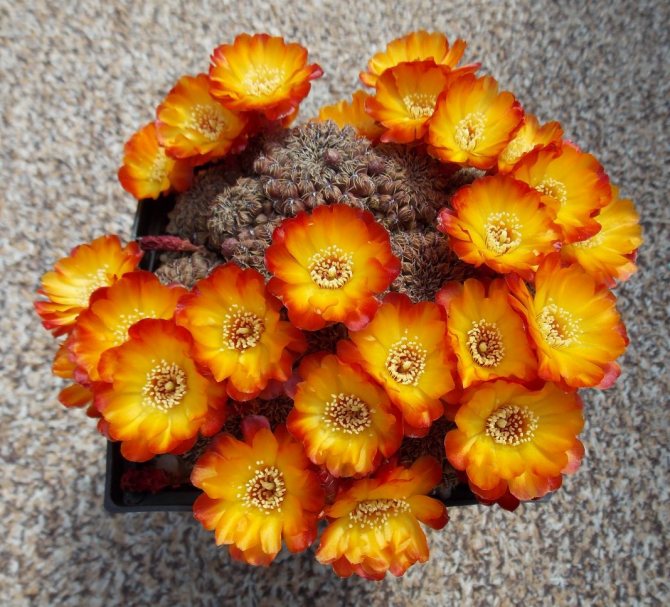

Rebutia
Care difficulties
- Ticks are a common problem. Treat the surface with a brush moistened with alcohol.
- Elongated stem - insufficient lighting and too high temperature in winter.
- Stopping growth is an insufficient amount of nutrients, poor watering in the summer, or an excess of moisture in the winter.
- The stem is shriveled, the appearance of rot in the lower part is a waterlogged substrate.
- Brown spots are sunburn.
- Soft brown spots - stem rot. Carefully cut out the affected area and disinfect it. Reason for violation of content.
- Root rot appears due to improperly selected soil components. Perhaps the root collar is buried too far, excessive watering.

